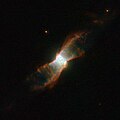Súbor:NGC 6881 HST.jpg
Vzhľad
NGC_6881_HST.jpg (532 × 532 pixelov, veľkosť súboru: 129 KB, MIME typ: image/jpeg)
História súboru
Po kliknutí na dátum/čas uvidíte ako súbor vyzeral vtedy.
| Dátum/Čas | Náhľad | Rozmery | Používateľ | Komentár | |
|---|---|---|---|---|---|
| aktuálna | 09:13, 31. december 2019 |  | 532 × 532 (129 KB) | BevinKacon | actual size from source |
| 12:18, 12. marec 2012 |  | 1 280 × 1 280 (266 KB) | Jmencisom |
Použitie súboru
Na tento súbor odkazuje nasledujúca stránka:
Globálne využitie súborov
Nasledovné ďalšie wiki používajú tento súbor:
- Použitie na ar.wikipedia.org
- Použitie na az.wikipedia.org
- Použitie na be.wikipedia.org
- Použitie na bs.wikipedia.org
- Použitie na ce.wikipedia.org
- Použitie na de.wikipedia.org
- Použitie na diq.wikipedia.org
- Použitie na en.wikipedia.org
- Použitie na en.wikiversity.org
- Použitie na eo.wikipedia.org
- Použitie na eu.wikipedia.org
- Použitie na fa.wikipedia.org
- Použitie na fr.wikipedia.org
- Použitie na hr.wikipedia.org
- Použitie na kk.wikipedia.org
- Použitie na lb.wikipedia.org
- Použitie na mk.wikipedia.org
- Použitie na my.wikipedia.org
- Použitie na nl.wikipedia.org
- Použitie na pl.wikipedia.org
- Použitie na pt.wikipedia.org
- Použitie na ro.wikipedia.org
- Použitie na ru.wikipedia.org
- Použitie na sr.wikipedia.org
- Použitie na tr.wikipedia.org
- Použitie na tt.wikipedia.org
- Použitie na uk.wikipedia.org
- Použitie na uz.wikipedia.org
- Použitie na www.wikidata.org

